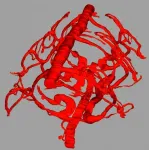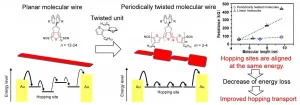Sugars influence cell-to-surface adhesion
Biotechnologists measure the forces with which algae cells adhere to surfaces and move on them
2021-01-02
(Press-News.org) How can cells adhere to surfaces and move on them? This is a question which was investigated by an international team of researchers headed by Prof. Michael Hippler from the University of Münster and Prof. Kaiyao Huang from the Institute of Hydrobiology (Chinese Academy of Sciences, Wuhan, China). The researchers used the green alga Chlamydomonas reinhardtii as their model organism. They manipulated the alga by altering the sugar modifications in proteins on the cell surface. As a result, they were able to alter the cellular surface adhesion, also known as adhesion force. The results have now been published in the open access scientific journal eLife.
Background and methodology
In order to move, the green alga has two thread-like flagella on its cell surface. The alga actually uses these flagella for swimming, but it can also use them to adhere to surfaces and glide along them. The researchers now wanted to find out how movement and adhesion on the part of the alga can be manipulated. "We discovered that proteins on cell surfaces that are involved in this process are modified by certain sugars. If these sugar chains on the proteins are altered, this enables their properties to be altered," explains Michael Hippler from the Institute of the Biology and Biotechnology of Plants at Münster University. Experts then describe such proteins as being N-glycosylated - a modification in which carbohydrates are docked onto amino groups. Alterations to these sugar modifications by genetically manipulating the algae showed that the adhesion force of the algae and, as a result, any adhesion to surfaces were reduced. At the same time, there was no change in the cells gliding on the surface. The much-reduced force with which the mutants adhere to surfaces is therefore still sufficient, under laboratory conditions, to enable gliding to take place.
In order to study these processes, the researchers first used so-called insertional mutagenesis and the CRISPR/Cas9 method to deactivate genes which encode enzymes relevant to the N-glycosylation process. "The next step was to analyse the sugar modifications of these genetically altered algae strains using mass spectrometry methods," says Michael Hippler, explaining the team's approach. In order to visualise the cell-gliding, the researchers used a special method of optical microscopy - total internal reflection fluorescence microscopy (TIRF). This method is frequently used to carry out examinations of structures which are located very close to a surface. For this purpose, a fluorescent protein was expressed in the flagella of the algae in order to make the flagella and the cell-gliding visible.
In order to measure how much force was used in adhering the individual cells to the surface, atomic force microscopy was used and micropipette adhesion measurements were undertaken in collaboration with groups at the University of Liverpool (UK) and the Max Planck Institute of Dynamics and Self-Organization in Göttingen. "This enabled us to verify that adhesion forces in the nanometre range are reduced by altering the protein sugar modifications," adds Kaiyao Huang.
The two flagella on the green alga resemble for example not only the flagella of sperm but also other movable flagella. These are usually called 'cilia' and are also found in the human body - for example in the respiratory tracts. "If we transfer our findings to human cells, sugar-modified proteins could be used to change the interaction of sperm or cilia with all sorts of surfaces," say Kaiyao Huang and Michael Hippler.
INFORMATION:
Research participants
Besides researchers from the University of Münster, scientists from Berlin's Humboldt University, the Universities of Wuhan (China) and Liverpool (England) and the Max Planck Institute of Dynamics and Self-Organization in Göttingen contributed to the study.
[Attachments] See images for this press release:

ELSE PRESS RELEASES FROM THIS DATE:
2021-01-02
Thanks to the marine worm Platynereis dumerilii, an animal whose genes have evolved very slowly, scientists from CNRS, Université de Paris and Sorbonne Université, in association with others at the University of Saint Petersburg and the University of Rio de Janeiro, have shown that while haemoglobin appeared independently in several species, it actually descends from a single gene transmitted to all by their last common ancestor. These findings were published on 29 December 2020 in BMC Evolutionary Biology.
Having red blood is not peculiar to humans or mammals. ...
2021-01-02
Osaka, Japan - Researchers at Osaka University synthesized twisted molecular wires just one molecule thick that can conduct electricity with less resistance compared with previous devices. This work may lead to carbon-based electronic devices that require fewer toxic materials or harsh processing methods.
Organic conductors, which are carbon-based materials that can conduct electricity, are an exciting new technology. Compared with conventional silicon electronics, organic conductors can be synthesized more easily, and can even be made into molecular wires. However, these structures suffer from reduced electrical conductivity, which prevents ...
2021-01-02
After "COVID-19," the term that most people will remember best from 2020 is likely to be "social distancing." While it most commonly applied to social gatherings with family and friends, it has impacted the way many receive medical care. Historically, the United States has been relatively slow to broadly adopt telemedicine, largely emphasizing in-person visits.
However, the COVID-19 pandemic, especially in the spring of 2020, necessitated increased use of virtual or phone call visits, even prompting the Center for Medicare and Medicaid Services (CMS) to relax some of its regulations, primarily for video-based ...
2021-01-02
N-Aryl-C-nitroazoles are an important class of heterocyclic compounds. They are used as pesticides and fungicides. However, these substances could be toxic to humans and cause mutations. As they are not frequently used, there is little data about them in the medicinal chemistry literature. However, it has been suggested recently that the groups of compounds that are traditionally avoided can help to fight pathogenic bacteria. Yet, to reduce toxic effects, a great amount of work must be carried out at the molecular level, ...
2021-01-02
The flag leaf is the last to emerge, indicating the transition from crop growth to grain production. Photosynthesis in this leaf provides the majority of the carbohydrates needed for grain filling--so it is the most important leaf for yield potential. A team from the University of Illinois and the International Rice Research Institute (IRRI) found that some flag leaves of different varieties of rice transform light and carbon dioxide into carbohydrates better than others. This finding could potentially open new opportunities for breeding higher yielding rice varieties.
Published ...
2021-01-02
In a study that looked at suicide deaths during 2020's first wave of the COVID-19 pandemic in Maryland, Johns Hopkins Medicine researchers found that, contrary to general predictions of suicides skyrocketing, suicides in the overall population actually dropped, relative to previous years. However, the researchers also discovered that suicide deaths increased dramatically among Black Marylanders during the same period.
The researchers say that their findings, published Dec. 16, 2020, in JAMA Psychiatry, highlight the importance of timely identification of high-risk groups and vulnerable populations to reduce suicide numbers.
Black Americans have been ...
2021-01-02
LOS ANGELES -- Scientists from the UCLA Jonsson Comprehensive Cancer Center have developed a simple, high-throughput method for transferring isolated mitochondria and their associated mitochondrial DNA into mammalian cells. This approach enables researchers to tailor a key genetic component of cells, to study and potentially treat debilitating diseases such as cancer, diabetes and metabolic disorders.
A study, published today in the journal Cell Reports, describes how the new UCLA-developed device, called MitoPunch, transfers mitochondria into 100,000 or more recipient cells simultaneously, which is a significant improvement from existing mitochondrial transfer technologies. The device is ...
2021-01-02
AURORA, Colo. (Dec. 29, 2020) - College football players may underestimate their risk of injury and concussion, according to a new study published today in JAMA Network Open.
Christine Baugh, PhD, MPH, assistant professor of medicine at the University of Colorado School of Medicine and member of the CU Center for Bioethics and Humanities, is the corresponding author of the article, "Accuracy of US College Football Players' Estimates of Their Risk of Concussion or Injury."
Baugh and co-authors report on survey results of 296 college football players from four teams in the Power 5 Conferences of ...
2021-01-02
People have puzzled for years why pathogen Phytophthora infestens causes the devastating late blight disease, source of the Irish Potato famine, on potatoes, but has no effect at all on plants like apple or cucumber. How are apple trees and cucumber plants able to completely shake off this devastating pathogen? Agricultural scientists have wondered for years: if this resistance is so complete and persists over so many generations, is there some way we could transfer it to susceptible plants like wheat and thereby stop disease?
Why is it so important to determine the molecular basis of nonhost resistance? ...
2021-01-02
Toronto - With the arrival of effective vaccines for the COVID-19 virus, the end of the pandemic is on the horizon but in the short term the virus continues to spread.
A timely new study published today by PLOS ONE examines the effectiveness of COVID-19 control policies in 40 jurisdictions including countries and U.S. states.
Among the conclusions is that significant social costs must be incurred to reduce the growth of the virus below zero. In most jurisdictions examined, policies with a lesser social impact including cancellation of public events, restrictions of gatherings ...
LAST 30 PRESS RELEASES:
[Press-News.org] Sugars influence cell-to-surface adhesion
Biotechnologists measure the forces with which algae cells adhere to surfaces and move on them




